
-
@bubba, I've heard of this lens before. AFAIK, it takes each image at a different time - that will give you the absolute worst kind of video sync, exactly what we're trying to avoid here. Motion will look v. weird.
Although for the special-case of shutter glasses viewing that is actually ideal, as the shutters are doing the same thing. But for any other kind (ie. where both images are displayed at the same time) it will look terrible.
-
@ Tom3D
@ _gl
Just ordered the NX1. Almost ordered the NX30, earlier because of the 3D lens option. Just found out that the NX1 supports the 45mm 3D lens ...so you know I had to order!
I have some new BMPCC (and unused GH2 pairs) for sale that I'd bought ...hoping someone here on personal-view would develop a 3D system. Thanks for all your work. You've kept me interested, and I appreciate that. Thanks again -
Let us know how it goes. :)
-
That would be sweet. (also gave me some grease tips on how to repair my aging printer, whose print head keeps catching on the rod : ).
My bodies are shipping today (woohoo). Couldn't quite get consecutive serials, but one apart ain't so bad.
-
I hope I can find the time, I'd base it around 3D printer parts too, using 8mm smooth rods for IA movement and stepper motors for IA / Convergence.
http://reprap.org/wiki/Smooth_rod http://reprap.org/wiki/Linear_bearing
-
Makes sense. Plus if you need a few attempts could be v. expensive.
-
FDM printing yourself is incredibly cheap, pennies. But when you go 3rd party you are paying for time on the printer which can be very expensive as printing is a slow process.
-
Hey @Tom3D, yeah I've been meaning to build a macro-box myself for years now : ). Just too many things on the go, but I do want some macro stuff eventually.
3D printing sounds a good idea. Haven't looked into it for anything yet, is it expensive to have someone else do it? I assume you'd need to iterate it a couple of times to iron out any bugs in the design. I could probably DIY something, but it would be neat to have it printed & lightweight.
I could also use it for the 3D preview monitor I've half-built. It's 2 raw 720p LCD panels + HDMI controllers. The idea is to beamsplit it like these monitors: http://www.ny3d.org/2007/06/planar_systems_inc_beaverton_o.html . I have everything except the case, would ideally like it to be collapsible.
-
I have some mirrors that were cut for a mini si2k rig, so in theory 8mm on the bmpcc should give the widest view and full zero to 65mm ia
By my light estimation including mirror and expensive shapeways printing it would come well under 1000usd
Would be interested to find if this works if the bmc uses the same clock, with SDI outputs they lend themselves to standard 3d workflows much better.
-
Incredible stuff, feel like i missed out by not picking up two bmpcc when they were cheap! I was thinking of making a gopro beamsplitter (only for narrow fov) but still haven't spared the money for a 3d printer
-
Thanks for your advices ! I wait to your own tests ^^
-
D'oh ignore, I missed you posted a YT3D version : ).
OK now I see the footage more clearly, it's badly out of sync. More than a frame I think. Easy to see eg. on the flashing light, but also all movement looks weird.
I check whole-frame sync by making a clicking sound into both mics on my GH2's at the start of each shot, and then aligning the audio waveforms in Premiere. Another option is a small flash, maybe an LED torch or something, or a clapper. When you don't have that (I sometimes forget), look for a sudden visual change in the footage (eg. like that flashing light), or body movement etc, and match that.
-
Hey @yannkibongui, good to have you on board. I think the battery level is a coincidence (but you can double-check). A power-button hack may work, but if we can find another action that resets the sensor timing, and that we can trigger simultaneously on both bodies, that would be even better (no hardware hacking or power cycling required).
If you have a CRT that's the best way to test the exact sync differences.
I actually finally got my two bodies yesterday - but my seller did not send closely matching serial nos (I made a big point about it but they forgot in the end), so I had to send them back. I should get consecutive ones in a week or so. I'm still going to look into hacking the clocks directly, but having closely matched bodies should minimize drift with the sync workarounds.
The depth seems fine in your shots, but the anaglyph ghosting is bad on my screen. Have you tried Youtube 3D? It supports 3D displays like my LG passive.
-
As we received our second bmpcc camera, we wanted to try some stereoscopic 3D footage. I've made a diy lanc splitter to sync cameras. It seems to work !
If you have any problem with the youtube player there is an anaglyph version here :I just noticed that's at low battery, the camera that have the higher battery level can start 1 or 1/2 frame before the second one... I have to try again with external battery power to see if its avoid this fact. If I still have this issue I plan to use 2 lanc controller (one for each camera) and solder on rec switch that activate both controller at the same time.
But after reading this topic I understand that the source of the problem could be elsewhere... I'm new to stereoscopic shooting and I've seen here that this 1/2 frame could be a processor clock problem : if cameras are not power on at the exact same time, they can not be synced. So I think about powering on both camera at the same time with an hardware hack, by soldering a button connected to the power button of both cameras.
Now I think about making a mirror rig because of the opposite rolling shutter on upside down rigs you were talking about. Also it will be more easy to achieve for macro shots.
But Anyway, that's working ! I'm curious about your feedback about the 3D depth, even if these test footage are ugly.
-
Still waiting on my bodies (no firm ETA right now, though I should be in the next batch).
Did you get a chance to try the from-playback mode test @David_Wilson?
-
OK I'll leave the hardware alone for a while until we get better pictures, somebody else has some ideas or I get to open mine. I looked up a couple more chips and marked a few things to help make sense of the board (pics). Corrections/additions/ideas welcome.
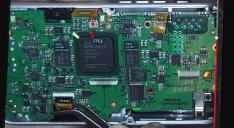
 front_marked.jpg2627 x 1438 - 931K
front_marked.jpg2627 x 1438 - 931K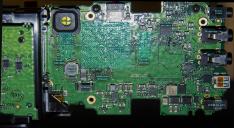
 back_marked.jpg2627 x 1438 - 1M
back_marked.jpg2627 x 1438 - 1M -
I've identified the possible FPGA clock pins (see pic) - the green ones 'GCLK' (global clock inputs) are the most likely. As I understand it, only a single pin needs to be used, in which case it's going to be a P_GCLK (positive).
I then worried about how a 32 kHz clock can drive an FPGA in any useful way (you'd expect them to run in the mHz range), so I studied the Spartan-6 clocking options: http://www.xilinx.com/support/documentation/user_guides/ug382.pdf
Good news and bad news:
the chip can (optionally) multiply the clock internally, so it is possible that it slaves to the slow input clock.
it can also (optionally) use its own internal oscillator, which only needs to be stimulated by an incoming clock until it's locked in. After that it's free-running, so it would be subject to drift between bodies, with no way to synchronize!
As both are optional (the chip can be configured in a zillion different ways), it totally depends on how BM is using it. The PDF mentions that in video applications, the incoming clock is often a slow pixel clock, and is then multiplied up internally. So there's a good chance we can sync it.
I'm buying an oscilloscope so that when I (eventually) open one up, I can see what the clocks are doing. It will be a while before I do though, I don't want to void the warranties until I'm sure that the sensors etc. are completely fine.

 spartan6_LX75_clockpins.gif1052 x 1392 - 134K
spartan6_LX75_clockpins.gif1052 x 1392 - 134K -
"If so, please try when they aren't doing anything." Will do.
-
Pocket power draw: 6.8W (according to BMD) = 0.57A @ 12V
So with my 6800mah battery & 2 bodies = theoretical 6 hours runtime (ballpark). Obviously extra power for stabilised lenses & other gadgets (eg. 12V HDMI monitors) need to be factored in, pretty decent though.
Do Pockets need a battery installed to use external power?
-
re. splitting power, if you don't want to make your own cables, 2.1mm DC splitter cables are common on Ebay: http://www.ebay.co.uk/sch/i.html?_odkw=%220.7mm%22+dc&_osacat=0&_from=R40&LH_PrefLoc=2&_trksid=p2045573.m570.l1313.TR12.TRC2.A0.H0.X2.1mm+dc+splitter&_nkw=2.1mm+dc+splitter&_sacat=0
(my Ebay batteries also use 2.1mm).You can get various 0.7mm adapters for them: http://www.ebay.co.uk/sch/i.html?_odkw=%220.7mm%22+dc+splitter&_osacat=0&_from=R40&LH_PrefLoc=2&_trksid=p2045573.m570.l1313.TR0.TRC0.H0.X%220.7mm%22+dc+&_nkw=%220.7mm%22+dc+&_sacat=0
I think I'll go with adapters, as 2.1mm cables/sockets/plugs are much easier to get and replace if one goes bad.
EDIT: of course we want a right-angle plug to get the closest interaxials. This DIY cable from China is the cheapest solution: http://www.ebay.com/itm/251583079697 (they don't ship to England though for some reason - maybe just a mistake, I've messaged them).
Or you can buy ready-made ones from eg. Lanparte (expensive though): http://www.ebay.com/sch/i.html?_from=R40&_sacat=0&_sop=15&_nkw=Lanparte+BMPCC+DC&rt=nc&LH_PrefLoc=2
-
@David_Wilson, you said earlier that pressing record when in playback mode is resetting the clocks, but that the bodies weren't in sync afterwards anyway. Were you playing back a clip at that point, or where you paused/stopped?
If you were playing, the cameras may have been too busy to react quickly enough to the record cmd. If so, please try when they aren't doing anything.
-
Stared at this some more, my latest guess:
- according to the SMD Codebook (http://www.marsport.org.uk/smd), OX (although they list a lower-case 'x') may be these Schottky diodes: http://www.avagotech.com/pages/en/rf_microwave/diodes/schottky/hsms-280r ). The 6 pin package matches (although there is a weird shadow on the component on the screencap that makes it look like a 4 pin device, I think it's 6?).
(the idea is that there isn't enough space on many SMD components to write proper device codes, so often you just get some cryptic 2 or 3 letters).
If so, the (assumed) 32kHz crystal seems the primary clock source:
- it's feeding the (assumed) DS1307 RTC (hence the 32kHz assumption).
- the RTC can optionally output a digital clock. Its pin is markedly soldered, and seems to lead towards the FPGA pins. So this probably clocks the FPGA digitally:
"Pin 7: SQW/OUT Square Wave/Output Driver. When enabled, the SQWE bit set to 1, the SQW/OUT pin outputs one of four square-wave frequencies (1Hz, 4kHz, 8kHz, 32kHz). The SQW/OUT pin is open drain and requires an external pullup resistor. SQW/OUT operates with either VCC or VBAT applied. The pullup voltage can be up to 5.5V regardless of the voltage on VCC. If not used, this pin can be left floating."
If true, then:
- it seems likely that it also (directly or indirectly) clocks the sensor. So rather than hack into the crystal itself (which is capacitance sensitive), the approach might be to cut the RTC's clock out pin, and insert the cloned clock from the other body's RTC there instead.
(it shouldn't matter that the RTC's themselves aren't synced, as they only do low-precision time/date keeping)
- the DS1307 datasheet says that its clock output is optional, and defaults to off on powerup. So something else must be programming it to enable the clock. Maybe the processor with its own crystal (Y2) on the front is in charge of booting the rest of the system? This would make sense, it would be scanning the power button when everything else is shut down, and then booting the FPGA by enabling the RTC clock output.
Cutting & soldering the RTC pin should be easier than trying to mess with SMD components, seems doable (if I'm right).
Even if all that works, I wonder what happens if one body boots faster than the other. So if the slave gets the clock, but can't use it yet, they may still start out of sync. There would be no drift, but there would be a permanent sync offset.
Thoughts?
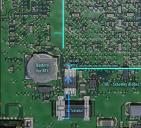
 clocks_best_guesses3.jpg1190 x 1078 - 381K
clocks_best_guesses3.jpg1190 x 1078 - 381K -
FGPA details:
Family : Spartan-6 Type : FGG484 Device : LX75 (280 avail. User IOs, 140 Differential Pairs) Package : BGA Size : 23x23mm Max IOs : 338 Pitch : 1.00mmIf someone can take a look, details on how it's clocked & pin locations: http://www.xilinx.com/support/documentation/user_guides/ug382.pdf What I'm looking for is which pin(s) on the FPGA are receiving global clock(s), and matching them to the rear board picture (full version: http://www.personal-view.com/talks/discussion/comment/176953#Comment_176953), so we can trace the clock source.
I've updated my best-guess picture a little (below), but I'm having a hard time following the traces. Also am I right in assuming that the large darker patches in various places on the circuit are ground planes?
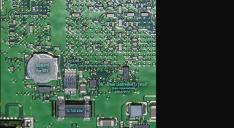
 clocks_best_guesses2.jpg1970 x 1078 - 488K
clocks_best_guesses2.jpg1970 x 1078 - 488K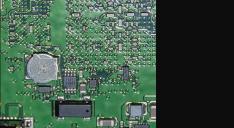
 clocks_best_guesses2 (no overlays).jpg2627 x 1438 - 682K
clocks_best_guesses2 (no overlays).jpg2627 x 1438 - 682K -
OK, these are my best guesses about the clocks so far:
RTC (time/date with battery backup): DS1307 (not marked 'DS', but pins make sense): http://datasheets.maximintegrated.com/en/ds/DS1307.pdf
Y1: 32.768 kHz crystal (for RTC, maybe also drives the rest). Looks unmarked, which would match this one visually (and specs match RTC requirements): http://www.digikey.co.uk/product-detail/en/CM200S-32.768KDZB-UT/300-8317-6-ND/862955
OX: Oven controlled crystal? Need better pic.
Sound right?
The field of pins top/right is the FPGA, so a clock should hit its pin(s) somewhere. @kavadni, can you try to trace the sync pins you found to one of these chips? Didn't get time today.
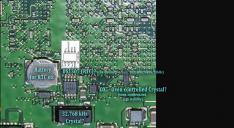
 clocks_best_guesses.jpg1708 x 935 - 427K
clocks_best_guesses.jpg1708 x 935 - 427K -
I don't have a power splitting cable to these. I should probably think about getting one. I'm pretty sure, however, that turning on the camera does reset the sync clock.
I hear you about the crystals and especially not disabling both cameras for other shooting.
Life in these parts is typically lived on the shortest of shoestrings as well. On occasion we get lucky - this project got funded which gives us some true breathing room for a change.
Actually, I would truly recommend Cave of Forgotten Dreams if you ever have a chance to see in in 3D. The sections where they took a matched pair of fully synced SI2Ks into the cave of completely beautiful 32,000 year old paintings is some of the best use of 3D I've ever seen. Other parts of the film where they shot with unsynced handy-cams of some flavor have some pretty uncomfortable shutter sync problems.
I'm very hopeful about your thoughts for slaving one camera sync to the other even if we don't get there in time for this project of ours. Having a truly reliable, high quality stereo camera system with possibilities for IO variation etc. would be a long time dream come true. The closest I ever came was a pair of synced Nizo S8 cameras many decades ago.
Howdy, Stranger!
It looks like you're new here. If you want to get involved, click one of these buttons!
Categories
- Topics List23,992
- Blog5,725
- General and News1,354
- Hacks and Patches1,153
- ↳ Top Settings33
- ↳ Beginners256
- ↳ Archives402
- ↳ Hacks News and Development56
- Cameras2,367
- ↳ Panasonic995
- ↳ Canon118
- ↳ Sony156
- ↳ Nikon96
- ↳ Pentax and Samsung70
- ↳ Olympus and Fujifilm101
- ↳ Compacts and Camcorders300
- ↳ Smartphones for video97
- ↳ Pro Video Cameras191
- ↳ BlackMagic and other raw cameras116
- Skill1,960
- ↳ Business and distribution66
- ↳ Preparation, scripts and legal38
- ↳ Art149
- ↳ Import, Convert, Exporting291
- ↳ Editors191
- ↳ Effects and stunts115
- ↳ Color grading197
- ↳ Sound and Music280
- ↳ Lighting96
- ↳ Software and storage tips266
- Gear5,420
- ↳ Filters, Adapters, Matte boxes344
- ↳ Lenses1,582
- ↳ Follow focus and gears93
- ↳ Sound499
- ↳ Lighting gear314
- ↳ Camera movement230
- ↳ Gimbals and copters302
- ↳ Rigs and related stuff273
- ↳ Power solutions83
- ↳ Monitors and viewfinders340
- ↳ Tripods and fluid heads139
- ↳ Storage286
- ↳ Computers and studio gear560
- ↳ VR and 3D248
- Showcase1,859
- Marketplace2,834
- Offtopic1,320
Tags in Topic
- camera 247
- rig 106
- cinema 73
- bmpcc 61
- 3d 60
- pocket 26
- sync 12
- synchronization 3
- stereoscopic 3




